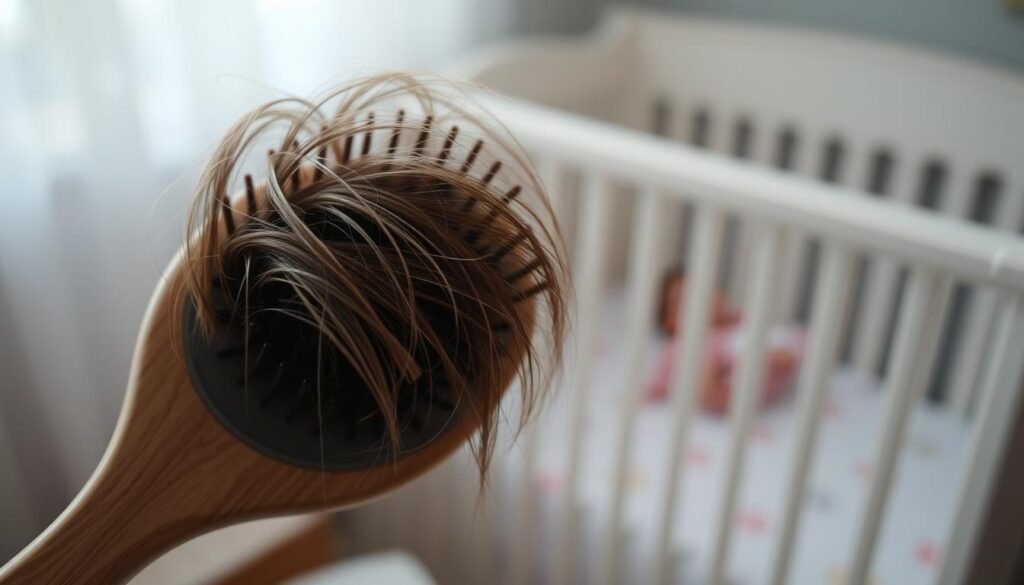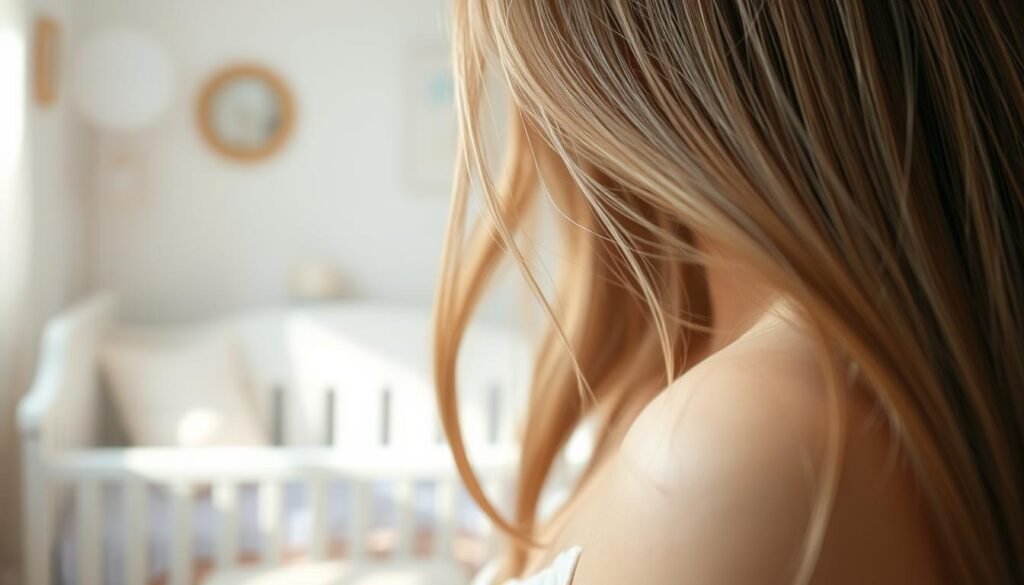About 40-50% of women face postpartum hair loss, known as telogen effluvium. This usually starts three months after childbirth. It might go on for three to six months. Sometimes, it even lasts up to a year. It’s key for new moms to know this condition is normal and happens due to hormonal changes.
Within six months after the birth, most women see their hair’s fullness return. This helps ease worries about the future health of their hair.
Key Takeaways
- Around 40-50% of women experience postpartum hair loss around three months after childbirth.
- This hair shedding typically lasts for about three to six months postpartum.
- Most women’s hair returns to its pre-pregnancy fullness by their child’s first birthday.
- Hormonal changes can affect hair texture and contribute to postpartum hair loss.
- A balanced diet rich in vitamins and minerals is essential for restoring hair health.
- Changing hairstyles and using specific products can help manage hair loss symptoms.
Introduction to Postpartum Hair Loss
Pregnancy is a time of big changes, and that includes hair changes after childbirth. Many new moms see their hair start to fall out about three months after having a baby. This can be shocking since you might lose more hair than the usual 100 strands a day. But understanding this postpartum hair loss overview can help ease worries about this natural process.
During pregnancy, you keep more hair because of hormone changes. After the baby comes, those levels drop quickly, and a lot of hair might fall out. It’s important to know this hair loss is often short-lived, going away when the baby turns one. This guide will help new moms know what to expect with their hair after childbirth.
To help with hair loss, living healthy is key. Keep taking prenatal vitamins, as they’re good for your hair. Try to stay away from harsh hair treatments and heat styling tools too. If you’re looking for more tips on dealing with hair loss, check out these resources.
Understanding Hair Growth During Pregnancy
Pregnancy brings significant hair growth changes. Elevated hormone levels, especially estrogen, make hair lush during pregnancy. Understanding these changes offers insights into pregnancy-induced hair growth.
The Role of Hormones
Pregnancy boosts hormone levels that affect hair growth. Estrogen extends hair follicles’ growth phase, resulting in thicker hair. By 15 weeks, women often notice fuller hair, thanks to increased estrogen. Progesterone also improves hair and skin, making hair look healthier.
Facilitating Hair Retention
During this phase, 85 to 95 percent of hair actively grows. Thus, women tend to lose fewer hairs at this time. After birth, hormone levels drop, returning to a normal shedding cycle. Around three months postpartum, a phase called telogen effluvium may cause noticeable hair loss. Knowing about this shift helps ease concerns about hair loss.
| Timeline | Hair Growth Phase | Impact of Hormones |
|---|---|---|
| Before Pregnancy | Normal growth (85-95% active) | Average shedding of 50-100 hairs/day |
| Week 15 of Pregnancy | Thicker appearance | Increased estrogen reduces shedding |
| 3 Months Postpartum | Begins telogen effluvium | Hormonal levels fluctuate |
| 6 Months Postpartum | Hair loss typically ceases | Return to normal hormonal balance |
| 1 Year Postpartum | Hair regrows to pre-pregnancy thickness | Consultation if not full recovery |
Overview of Postpartum Hair Loss
It’s crucial for new moms to understand postpartum hair loss. It affects many due to hormonal changes after having a baby. Knowing about postpartum hair loss provides comfort and insight during this time.
What is Postpartum Hair Loss?
About 40-50% of new moms experience postpartum hair loss, also known as telogen effluvium. This condition causes a lot of hair to shed. Though shocking, it’s a natural response to post-pregnancy hormonal adjustments.
Duration and Timing of Shedding
Hair loss usually starts three to four months post-birth. It often peaks around the fourth month. Usually, it lasts between three to six months, but can go up to a year for some.
By their baby’s first birthday, many moms see their hair’s original thickness return. This reduces worries about long-term hair loss.
| Timeframe | Hair Shedding Status | Expected Recovery |
|---|---|---|
| 0-3 Months | Stable | Hair growing normally |
| 3-4 Months | Initial shedding begins | Normal hormonal adjustments |
| 4 Months | Shedding peaks | Awareness of decreased volume |
| 6 Months | Shedding may decrease | Hair begins to return to fullness |
| 12 Months | Hair returns to pre-pregnancy state | If healthy hair practices are followed |
This is a temporary situation. Women can feel better knowing it just needs time and understanding.
Symptoms of Postpartum Hair Loss
About 40% to 50% of new moms face postpartum hair loss. Knowing the postpartum hair loss symptoms helps catch it early. This early detection ensures the right care. Typical signs are losing clumps of hair when washing or styling it. Hair might also thin overall, with more hair found on pillows or in brushes. Recognizing these hair shedding signs can ease worries. It also helps tell this condition apart from other hair loss types.
Signs to Look Out For
- Clumps of hair falling out during washing or combing
- Seeing loose strands on pillows after sleeping
- Overall thinning, particularly around the hairline
- Increased hair found in hairbrushes
These symptoms are usually short-lived. They often start about three months after giving birth, peaking at four months. Luckily, this shedding usually stops within six to fifteen months. It’s good to know that postpartum hair loss is often temporary alopecia called telogen effluvium. This is different from chronic conditions that need a doctor’s visit.
How Shedding Differs from Other Hair Loss Types
Postpartum hair shedding is often brief and ends a few months after birth. But, other hair loss types might point to health problems that need more checking. If hair loss lasts more than six months or is very bad, seeing a doctor is important. They can check for things like thyroid issues that also cause hair loss. For tips on handling postpartum hair loss, here’s a helpful resource.

| Postpartum Hair Loss | Other Hair Loss Types |
|---|---|
| Temporary shedding lasting up to 15 months | Chronic conditions, possibly permanent |
| Severe shedding around 3-4 months post-delivery | Variable onset and duration |
| Regrowth expected within a year | Potential for ongoing loss without intervention |
| Associated with hormonal changes | May stem from various health issues |
Causes of Postpartum Hair Loss
Understanding postpartum hair loss is vital for new moms. It’s a common issue tied to hormone changes after giving birth. These shifts affect the hair growth cycle, leading to hair loss.
Hormonal Changes after Childbirth
Post-delivery, the body experiences big hormonal changes. Levels of estrogen and progesterone fall sharply. This causes a lot of hair to move from growing to shedding. Normally, you might lose 100 hairs a day, but after childbirth, it could rise to 300, making hair loss more visible.
Other Contributing Factors
Besides hormonal shifts, other elements can play a part in hair loss after childbirth. These include:
- Stress: The new responsibilities of motherhood can lead to more stress, which might increase hair loss.
- Nutritional Deficiencies: Not getting enough nutrients like iron and vitamin D can harm hair health and lead to more shedding.
- Thyroid Conditions: If you already have thyroid issues, they can make postpartum hair loss worse.
Knowing these causes and factors helps moms manage their hair health better during such a big change in their lives.
| Factor | Description |
|---|---|
| Hormonal Changes | Significant drop in estrogen and progesterone leads to increased shedding. |
| Stress | Heightened stress levels post-birth can aggravate hair loss. |
| Nutritional Deficiencies | Lack of key nutrients can weaken hair, causing more loss. |
| Thyroid Issues | Pre-existing thyroid conditions may worsen postpartum hair loss. |
Management and Treatment Options
Addressing postpartum hair loss boosts a new mother’s confidence and well-being. Both dietary changes and special hair care routines are important. They help in this important time of change.
Diet and Nutritional Support
Eating well is key in dealing with postpartum hair loss. A diet full of essential vitamins and minerals aids in healthier hair growth and reduces shedding. Important nutrients for your hair include:
- B-vitamins: These are crucial for hair health, helping to create red blood cells and boost metabolism.
- Iron: To combat hair loss, eat more iron-rich foods like spinach, lentils, and leans meats.
- Zinc: It’s vital for the growth and repair of hair tissues. You can find it in nuts, seeds, and whole grains.
Hair Care Tips to Minimize Loss
Along with good nutrition, specific hair care methods also minimize loss:
- Wash and dry your hair gently with a soft towel to avoid breakage.
- Use hair accessories that don’t pull your hair, like fabric-covered elastics and wide-toothed combs.
- Steer clear of heat treatments and harsh styling, as they can lead to more hair loss.

Prevention Strategies for Postpartum Hair Loss
Starting prevention for postpartum hair loss during pregnancy is vital. Healthy hair habits are key to keeping hair strong after giving birth. Good nutrition and supplements can also boost hair health.
Healthy Hair Practices During Pregnancy
Healthy hair practices during pregnancy can lessen postpartum hair loss. Important steps include:
- Maintaining a balanced diet rich in essential nutrients
- Limiting heat styling and harsh chemical treatments
- Opting for gentler hairstyles to avoid tension on hair shafts
- Utilizing natural hair care products to reduce exposure to damaging chemicals
- Practicing stress reduction techniques, such as yoga or meditation
The Importance of Prenatal Vitamins
Prenatal vitamins are crucial for hair health before and after pregnancy. These vitamins provide key nutrients for stronger hair growth, like:
| Nutrient | Benefit for Hair Health |
|---|---|
| Vitamin B Complex | Promotes hair growth and reduces hair thinning |
| Biotin | Strengthens hair and enhances overall growth |
| Iron | Prevents hair loss by supporting oxygen delivery |
| Vitamin C | Aids in collagen production and iron absorption |
| Vitamin E | Improves scalp circulation, promoting healthy hair follicles |
| Zinc | Supports tissue growth and repair, promoting resilience |
Using these strategies creates a strong base for healthier hair in the postpartum phase. By focusing on nutrition and healthy hair habits, women can minimize hair loss. This helps in their recovery after having a baby.
Outlook and Prognosis of Postpartum Hair Loss
Most people find that postpartum hair loss gets better with time. It’s important to know about the recovery timeline. This knowledge can help ease worries about hair loss after having a baby.
Many women lose more hair than usual because of changes in hormones. This is especially true when estrogen levels go down. Hair often moves from growing to resting because of this.

Understanding the Recovery Timeline
The most hair shedding happens in the first six months after birth. Within a year, most women’s hair goes back to how it was before pregnancy. By six months, hair loss typically stops and new growth begins in thin spots.
If hair loss goes on after six months, you might need a check-up. This helps make sure there are no other issues causing the hair loss.
When to Seek Professional Help
Postpartum hair loss is often short-term. But if it lasts longer than six months or gets worse, get help. Talking to a healthcare provider is a good step. They can check things out and guide you on what to do next.
Living with Postpartum Hair Loss
Postpartum hair loss is a common challenge for new moms. About 40% to 50% of women deal with it. It can make you feel unsure about how you look. Knowing these feelings and dealing with them is key for your emotional health.
Emotional Impact on New Mothers
After having a baby, mothers face a lot of changes. Losing hair can make these challenges harder, leading to lower self-esteem. It’s important to understand these feelings to handle them better.
Building a Support System
Having a strong support network is very important. Talking with loved ones can offer comfort. It helps to talk about your feelings and stress. Joining support groups or getting counseling can also be helpful. This support is vital for emotional health during this time.
Highlights of Postpartum Hair Loss Research
Postpartum hair loss research is getting a lot of attention lately. It sheds light on how common it is and how long it lasts. Studies show that about 21% of women face hair loss after having a baby. A whopping 91.8% of these women see a lot of hair coming out. This shows it’s a widespread issue for new moms.
What Recent Studies Reveal
Studies found that hair loss usually starts around 3 months after giving birth. It peaks at about 5 months. But, most women get their hair back in 4 to 6 months. Women who breastfeed longer tend to lose more hair. Also, having a baby early can increase hair loss risk.
Innovations in Treatment Approaches
New treatments focus on fixing nutritional gaps, balancing hormones, and improving hair health. Stress, thyroid problems, and not having enough iron can slow down hair recovery. So, doctors suggest tailored plans to help hair grow back. The latest research is promising for new treatments. These findings help moms find effective ways to deal with hair loss during this big change in their lives.
Common Myths About Postpartum Hair Loss
It’s important for new moms to understand the myths about postpartum hair loss. A lot of misconceptions can cause worry. Knowing the truth helps moms feel better about hair loss after having a baby.
Busting Misconceptions
Many think postpartum hair loss means their hair won’t be healthy again. But this hair loss usually starts three months after childbirth and gets better in three to six months. It happens because of hormone changes and the stress of caring for a newborn. Despite what some believe, not washing hair often doesn’t stop hair. Washing with good products three times a week is better.
Clarifying Truth from Fiction
Some believe prenatal vitamins stop postpartum hair loss, but those vitamins mainly help the baby grow. Eating foods high in protein and iron is key for hair health after the baby is born. Also, there’s a myth about special foods that prevent hair loss. No food can stop it completely, but a healthy diet helps hair grow.
Every pregnancy is different, and more pregnancies don’t always mean more hair loss. Hair might thin as you get older, too. By understanding the myths about postpartum hair loss, moms can get the right info. This knowledge eases worries and makes the hair recovery journey clearer.
| Myth | Truth |
|---|---|
| Hair loss is permanent after childbirth. | Postpartum hair loss is usually temporary and resolves within a year. |
| Washing hair less often prevents hair loss. | Washing about three times a week with quality products is recommended. |
| Prenatal vitamins will help with postpartum hair loss. | Prenatal vitamins support baby development but do not directly prevent hair loss. |
| Anti-hair loss foods exist. | No specific food prevents hair loss, but a balanced diet promotes hair growth. |
Conclusion
Postpartum hair loss is something many new moms face. About 40% to 50% of them will see their hair start falling out 3 to 6 months after having a baby. This is mostly because of big changes in hormones, affecting up to 90% of new moms. The key point is knowing why it happens, spotting the signs, and understanding the treatments can make things easier.
Usually, hair starts growing back 6 to 12 months after it begins to fall out. So, even though losing hair can be upsetting, it usually doesn’t last forever. It’s super important for moms to use prevention methods and have people who support them during this time. With the right steps and information, they can feel hopeful about their hair growing back.
Last thoughts, dealing with hair loss after having a baby is about more than just the hair. It’s part of the bigger picture of a mom’s health. For more details or advice, health conditions linked to hair loss has lots of good info. Remembering that this hair loss isn’t permanent can give moms the strength they need to get through it.